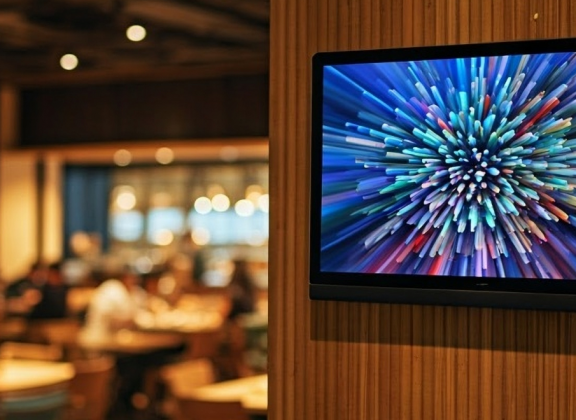Television may look old‑fashioned beside the glow of smartphones, yet nothing rivals a wall‑mounted display for sheer presence inside a hotel lobby or neighbourhood brasserie. Once those displays run on Internet Protocol Television (IPTV) instead of coaxial feeds, they shift from passive décor to dynamic touchpoints that speak in the establishment’s own voice. A well‑designed IPTV ecosystem greets visitors personally, steers them toward high‑margin services, and collects real‑time sentiment—all without increasing payroll or disrupting ambience. For retailers supplying set‑top boxes and media players, these outcomes are the strongest proof that selling hardware is really about enabling experience.
IPTV as the Nerve Centre of Guest Experience
Traditional broadcast signals offer identical content to every receiver, trapping venues in a one‑size‑fits‑all narrative. IPTV dissolves that constraint. By funnelling live channels, video‑on‑demand assets, digital signage, and social widgets through the same Ethernet or Wi‑Fi already delivering internet access, operators put every screen under a single pane of glass. Marketing teams schedule breakfast news beside muted weather tickers for early risers, then switch seamlessly to live sports and drink promotions after sunset. Because each end‑point is individually addressable, a rooftop terrace can showcase sunset‑themed cocktails while conference rooms stream simultaneous translations, maintaining brand unity without sacrificing local nuance.
Reimagining the Hotel Stay, Pixel by Pixel
The first seconds after check‑in shape overall satisfaction more than any loyalty programme email. With IPTV, that moment opens on a personalised dashboard: the set‑top box pulls data from the property‑management system, greets the guest by name, and highlights benefits aligned with their traveller profile. A couple on holiday sees spa packages and late‑checkout options, whereas a delegate attending a summit receives agenda reminders and private network credentials. Android TV and RDK platforms sustain the comfort of home streaming habits while safeguarding privacy through automatic credential purging at departure. Mid‑stay surveys embedded in the interface outperform post‑checkout questionnaires because feedback is immediate and actionable, allowing staff to course‑correct long before departure.
Dining Spaces That Monetise Attention
Restaurants live or die on dwell time and average ticket size—both of which IPTV can influence subtly. Digital menu boards rendered through the same media players sync with the point‑of‑sale database, updating prices or striking sold‑out items without frantic reprinting. Dynamic overlays respond to contextual triggers: a sudden downpour outside prompts indoor screens to advertise warm soups, while a championship match ignites limited‑edition beer specials. Chains that integrate these cues report revenue lifts of several percentage points within weeks, underscoring how strategic pixels outperform static posters.
Infrastructure, Investment, and Payback Logic
Four technical pillars uphold a future‑proof deployment: bandwidth, head‑end orchestration, rugged end‑points, and intuitive content software. High‑Efficiency Video Coding compresses full‑HD and 4K streams enough to travel over legacy Cat‑5e wiring, sparing businesses the cost of structural cabling upgrades. Segmented VLANs and conditional‑access modules isolate premium channels and personal browsing tokens from public networks, satisfying both cybersecurity auditors and media licensors. Industrial‑grade set‑top boxes—fanless, aluminium‑clad, and capable of twenty‑four‑hour operation—arrive pre‑configured from specialist retailers. Installation therefore becomes a plug‑and‑play afternoon rather than a protracted engineering project, squeezing capital expenditure into a payback window as short as a single fiscal quarter.
Translating Engagement into Quantifiable Loyalty
Because IPTV middleware logs every remote click and dwell metric, it converts qualitative ambience into data. Correlations between on‑screen offers and purchasing behaviour reveal which spa promotion or dessert pairing actually drives spend. Heat maps produced from table‑top players inform menu engineering with forensic precision, while A/B testing different visual treatments pinpoints the smallest design tweaks that unlock higher conversion. Crucially, these insights feed directly into the central CRM, closing the loop between content, transaction, and repeat visitation—an evidence‑based approach that outclasses gut‑feel branding.
Staying Agile Through Open Standards
Hospitality technology ages quickly under the twin pressures of guest expectation and licensing regulation. Choosing media players with open APIs, long‑term firmware support, and modular middleware keeps the estate adaptable to emerging codecs or new digital rights regimes. Retail partners committed to multi‑year security patches and overnight replacement pools ensure that screens remain alive during peak season, protecting both revenue and reputation. Open architecture also empowers properties to test cloud delivery, interactive casting, or gamified loyalty layers without scrapping perfectly serviceable hardware, reinforcing sustainability pledges alongside fiscal prudence.
IPTV transforms the familiar TV set into a programmable service node that moulds perception, steers revenue, and gathers intelligence. When restaurants and hotels combine robust network scaffolding with commercial‑grade set‑top boxes and data‑driven content management, they turn every display into an engine of loyalty—one that continues to work long after the diner has finished their espresso or the traveller has drawn the curtains for the night.
